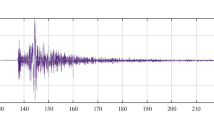Abstract
Ground Penetrating Radar (GPR) signatures of shallowly buried landmines are normally obscured by a strong background signal comprised of the reflections from the ground surface and the antenna crosstalk. Based on the notion that buried landmine produces an anomaly in the soil dielectric an automated procedure has been developed which detects soil dieletric anomalies of the size comparable to the size of landmine in GPR data and enhances the signatures of such anomalies. A local background estimate is computed and a soil dielectric anomaly is detected at the spatial position where a change from the estimated background signal occurs. A translation invariant wavelet packet decomposition is applied for detection. The computation takes place in a running window which allows for the algorithm to adapt to the variations in ground conditions and antenna height. The technique was tested using a number of minelike targets buried in several different soil environments and the testing results are presented.
Similar content being viewed by others
References
Daniels, D. J., 1996, Surface penetrating radar. Radar, sonar, navigation and avionics Series 6: IEE Press, London, UK.
Chant, I., Washl, J., and Bird, R., 1998, Develoment of ground penetrating radar as a landmine detector: Technical Report DSTO-TR-0653: Defence Science and Technology Organisation, Australia.
Bruschini, C., Gros, B., Guerne, F., Piece, P.-Y., and Carmona, O., 1998, Ground penetrating radar and imaging metal detectors for antipersonnel mine detection: Jour. Appl. Geophys., v. 40, p. 59–71.
Hewer, G., Kuo, G., and Peterson, L., 1996, Adaptive wavelet detection of transients using bootstrap: Proc. SPIE Wavelet Application, v. 2762, Orlando, USA, p. 105–114.
Cohen, A., and Landsberg, D., 1983, Adapative real-time wavelet detection: IEEE Trans. Biomed. Imag., v. 30, no. 6, p. 332–340.
Carmona, R. A., 1993, Wavelet identification of transients in noisy time series: Proc. SPIE Mathematical Imaging, v. 2034, Orlando, USA, p. 392–400.
Noel, S. E., Gohel, Y., and Szu, H. H., 1997, Wavelet detection of singularities in the presence of fractal noise: Proc. SPIE Wavelet Application, v. 3078, Orlando, USA, p. 374–383.
Guanghui, Z., Zailu, H., and Zhengquiang, H., 1993, Wavelet packets algorithm and its application in signal detection: Proc. SPIE Mathematical Imaging, v. 2034, Orlando, USA, p. 426–431.
Pesquet, J.-C., Krim, H., and Carfantan, H., 1996, Time-invariant orthonormal wavelet representations: IEEE Trans. Signal Process., v. 44, no. 8, p. 1964–1970.
Liang, J., and Parks, T. W., 1996, A translation-invariant wavelet representation algorithm with applications: IEEE Trans. Signal Process., v. 44, no. 2, p. 225–232.
Del Marco, S., and Weiss, J., 1994, M-band wavepacket-based transient signal detector using a translation-invariant wavelet transform: Optical Eng., v. 33, no. 7, p. 2175–2182.
Simoncelli, E. P., Freedman, W. T., Adelson, E. H., and Heeger, D. J., 1992, Shiftable multiscale transforms: IEEE Trans. Info. Theory, v. 38, no. 2, p. 587–607.
Coifman, R. R., and Wickerhauser, M. V., 1992, Entropy-based algorithms for best basis selection: IEEE Trans. Info. Theory, v. 38, no. 2, p. 713–718.
Daubechies, I., 1988, Orthonormal bases of compactly supported wavelets: Commun. Pure Appl. Math., v. XLI, p. 909–996.
Bear, M., and Kradolfer, U., 1987, An automatic phase picker for local and teleseismic events: Bull. Seism. Soc. Am., v. 87, no. 6, p. 1437–1445.
Wong, B. C. Y., Chant, I., Crisp, G. N., Kappra, K., Strugess, K., Rye, A., and Sherbondy, K., 1997, Suggested soil characterisation techniques and surrogate targets for ultra-wide band radar mine detection experiments: Proc. SPIE AeroSense, v. 3079, Orlando, USA, p. 555–567.
Murray, W., Williams, C. J., and Pollock, J. T. A., 1996, A high resolution radar for mine detection: Proc. EUREL Int. Conf., EICC, Edinburgh, UK, p. 143–147.
Carevic, D., Lee, D., Clonan, L., and Chant, I., 1999, Ground Penetrating Radar Measurement Series, February/March 1999. Internal Divisional Report DSTO-DP-0447: Surveillance Systems Division, Defence Science and Technology Organisation, Australia.
Carevic, D., and Chant, I., Feature extraction and classification of minelike targets from Ground Penetrating Radar data using Gaussian mixture models. Technical report: Defence Science and Technology Organisation, Australia (under review).
Daubechies, I., 1992, Ten lectures on wavelets: SIAM.
Author information
Authors and Affiliations
Rights and permissions
About this article
Cite this article
Carevic, D. Clutter Reduction and Detection of Minelike Objects in Ground Penetrating Radar Data Using Wavelets. Subsurface Sensing Technologies and Applications 1, 101–118 (2000). https://doi.org/10.1023/A:1010126810896
Issue Date:
DOI: https://doi.org/10.1023/A:1010126810896




